Kenneth C. Davis's Blog, page 11
July 4, 2023
GREAT SHORT BOOKS: A Year of Reading–Briefly

Two boxes of beautiful finished books have arrived (Author photo)
GREAT SHORT BOOKS:
A YEAR OF READING — BRIEFLY
NOW AVAILABLE
Scribner/Simon & Schuster and Simon Audio (Unabridged audio download)
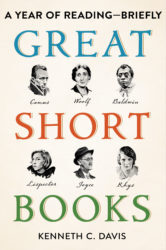
“An exciting guide to all that the world of fiction has to offer in 58 short novels — from ‘The Great Gatsby’ and ‘Lord of the Flies’ to the contemporary fiction of Colson Whitehead and Leïla Slimani — that, ‘like a first date,’ offer pleasure and excitement without commitment.” New York Times Book Review
Booklist “Editors’ Choice Adult Books 2022″
“…The most exceptional of the best books of 2022 reviewed in Booklist…”
“Delightfully accessible, Great Short Books: A Year of Reading–Briefly presents 58 fact-filled reviews of short books, a smorgasbord of titles sure to entice readers.” –Cheryl McKeon, Shelf Awareness
“I consider Davis’ ‘Great Short Books’ a gift to readers, a true treasure trove of literary recommendations.” —Sue Gilmore, SFGate
“Anyone who’s eternally time-strapped will treasure Kenneth C. Davis’ Great Short Books. This nifty volume highlights 58 works of fiction chosen by Davis for their size (small) and impact (enormous). Each brisk read weighs in at around 200 pages but has the oomph of an epic.” —Bookpage Full Review
“An entertaining journey with a fun, knowledgeable guide…. “ Kirkus Reviews
“A must-purchase for public and school libraries.” ALA Booklist
FIRST TRADE REVIEWS FROM KIRKUS, PUBLISHERS WEEKLY, BOOKLIST
“Davis feels that novels of 200 pages or less often don’t get the recognition they deserve, and this delightful book is the remedy…A must-purchase for public and school libraries.” *Starred Booklist review
“An entertaining journey with a fun, knowledgeable guide…. His love of books and reading shines through. From 1759 (Candide) to 2019 (The Nickel Boys), he’s got you covered.” –Kirkus Reviews
Full KIRKUS review here
“Davis’s conversational tone makes him a great guide to these literary aperitifs. This is sure to leave book lovers with something new to add to their lists.” FULL PUBLISHERS WEEKLY REVIEW here
During the lock-down, I swapped doom-scrolling for the insight and inspiration that come from reading great fiction. Inspired by Boccaccio’s “The Decameron” and its brief tales told during a pandemic, I read 58 great short novels –not as an escape but an antidote.
“A short novel is like a great first date. It can be extremely pleasant, even exciting, and memorable. Ideally, you leave wanting more. It can lead to greater possibilities. But there is no long-term commitment.”
–From “Notes of a Common Reader,” the Introduction to Great Short Books
Read “The Antidote to Everything,” an excerpt from the Introduction published on Lit Hub
The result is a compendium that goes from “Candide” to Colson Whitehead, and Edith Wharton to Leïla Slimani. And yes, Maus and many other Banned Books and Writers.

What “A Year of Reading–Briefly” looks like

Voltaire in Great Short Books
Art © Sam Kerr

Edith Wharton in Great Short Books
Art © Sam Kerr
Advance Praise for Great Short Books: A Year of Reading—Briefly
“GREAT SHORT BOOKS is a fascinating, thoughtful, and inspiring guide to a marvelous form of literature: the short novel. You can dip into this book anywhere you like, but I found myself reading it cover-to-cover, delighting in discovering new works while also revisiting many of my favorites. GREAT SHORT BOOKS is itself a great book—for those who are over-scheduled but want to expand their reading and for those who will simply delight in spending time with a passionate fellow reader who on every page reminds us why we need and love to read.”
–Will Schwalbe, New York Times bestselling author of THE END OF YOUR LIFE BOOK CLUB
“This is the book that you didn’t know you really needed. I began digging into this book as soon as I got it, and it was such a delight to read beautiful prose, just a sip at a time, with Kenneth Davis’ notes to give me context and help me more fully appreciate the stories. Keep this book near your bed or on your coffee table. It will be read and loved.”
–Celeste Headlee, journalist and author of WE NEED TO TALK and SPEAKING OF RACE

Recording audio book of Great Short Books (Sept. 2022) Photo by Katherine Cook
From hard-boiled fiction to magical realism, the 18th century to the present day, Great Short Books spans genres, cultures, countries, and time to present a diverse selection of acclaimed and canonical novels—plus a few bestsellers. Like browsing in your favorite bookstore, this eclectic compendium is a fun and practical book for any passionate reader hoping to broaden their collection— or anyone who is looking for an entertaining, effortless reentry into reading.
Listen to a sample of the audio book of Great Short Books
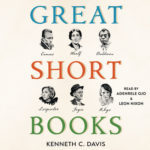
And Indie booksellers weigh in:
“Need something grand, something classic, uh…. something short to read, but don’t know where to start? Check out Kenneth Davis’s guide to Great Short Books and you’ll soon find just the right tale to delight your literary palate. For each suggestion, Davis gives us first lines, a plot summary, an author’s bio, a reason for reading it, and, finally, what you should read next from the author’s canon. Pick up a copy… you’ll be glad you did. You’re welcome!”—Linda Bond, Auntie’s Bookstore (Spokane, WA)
“Kenneth Davis has presented the perfect solution for too many books, not enough time—a collection of exceptional short books perfect for reading in a society seemingly without any free time. Many of the books may be familiar by name, some are obscure, some even forgotten, but all belong in the canon of superb literature. He teases with a brief synopsis and explains why each book deserves attention. An absolutely intriguing bonus is a short biographical sketch of each author, many of whom had fascinating but traumatic lives. It is the perfect book to provide comfort literature for busy readers.”—Bill Cusumano, Square Books (Oxford, Miss.)
More early reviews from readers at NetGalley.com
“GREAT SHORT BOOKS is a wonderful, breezy but deep look at the outstanding short books of the last 150 years. Kenneth C. Davis is a genius at summarizing each book and making the reader want to read said book post haste. This is a book I didn’t know the world needed but the world did.” –Tom O., reviewer
“…an incredibly valuable tool for book clubs and readers everywhere! Some authors/titles are well-known and others will be new discoveries….HIGHLY RECOMMENDED for any book group looking to find new titles or any reader who wants to know what to read next.” –Ann H. reviewer
“I found over a dozen new authors or titles I want to now read that were included in his main list, and the Further Reading at the end of each chapter and at the end of the volume itself.
As others have suggested, this is a great tool for Book Clubs!
Not Lit Crit, it is mostly focused on necessary, just-the-facts-mam information on one person’s reading of short books over a year. Well worth a read, and great for browsing!” –Stephen B., Librarian
“What better way to introduce new readers to more than 50 ‘short’ books. This handy book is full of non-spoiler descriptions and cultural context that situate these stories within our world.” –Kelsey W., librarian
S0urce: Great Short Books via NetGalley
I can’t wait to start talking about this book with readers everywhere.
Teachers, Librarians, Book Clubs and Other Learning Communities:
Invite me for a visit to your school, classroom, library, historical group, book club or conference.
The post GREAT SHORT BOOKS: A Year of Reading–Briefly first appeared on Don't Know Much.
When Robin Hood Was Blacklisted
Robin Hood was a Commie.
That, at least, is what an Indiana state textbook commissioner thought back in 1953. This official called for schools to ban books mentioning Robin Hood for the simple reason that Robin and his Merry Men robbed from the rich and gave to the poor. Their antics reeked suspiciously of godless Socialism.
It is easy to laugh off this overlooked history as an amusing bit of trivia. Except the Hoosier state assault on Robin Hood was part of a larger nationwide effort to ban books and suppress intellectual freedom. It was led by Senator Joseph McCarthy during the anti-Communist “witch hunts.” It targeted books, writers, and libraries both at home and around the world. And it holds pointed lessons about safeguarding democracy from the forces threatening it today.
After the 1947 blacklisting of the “Hollywood Ten” screenwriters by the House Un-American Affairs Committee (HUAC), Senator McCarthy emerged as the face and unrelenting voice of a crusade against Communist influences in America. In 1950, McCarthy claimed to possess an extensive list of Communists who worked in the State Department. Launching his war on alleged Communist infiltrators as chairman of a Senate committee on government operations, McCarthy was abetted by J. Edgar Hoover’s FBI. To be labeled a Communist was an accusation from which there was no escape. Claims of innocence or invoking the Fifth Amendment were tantamount to confession.
Set against the Korean War begun in 1950, and with the convictions of Alger Hiss that year for perjury over espionage and the Rosenbergs in 1951 for atomic spying, America’s fear of Communism spread like wildfire. Gaining an army of rabid followers, McCarthy’s crusade to root out subversives widened to focus intently on libraries, which were pressured to purge their collections of works by Marx. By 1952, the New York Times described a pervasive wave of educational book censorship in America. Around the country, self-appointed local committees— “volunteer educational dictators” in the words of one librarian—were coercing librarians to remove books considered “un-American,” the Times found.
This anti-Communist juggernaut was not only steam-rolling domestic libraries. McCarthy sent it on a road trip. In April 1953, McCarthy’s underlings, attorney Roy Cohn and associate David Schine, were dispatched to Europe. Part of their mission was to scrutinize U.S. Information Service libraries, created to provide war-ravaged countries with American books. McCarthy claimed that these collections held thousands of works by Communists. Targeting suspect authors, just as Hollywood had been purged of “Red” screenwriters, Cohn and Schine succeeded in intimidating foreign service officials. No fires were set, but titles by Dashiell Hammett, Lillian Hellman, and Howard Fast, among others, were pulled from the shelves.
Inaugurated in January 1953, President Eisenhower was hesitant to challenge McCarthy. But he discreetly fired back. He told a Dartmouth commencement audience in June of that year:
“Don’t join the book burners. Don’t think you are going to conceal faults by concealing evidence that they ever existed. Don’t be afraid to go in your library and read every book, as long as that document does not offend our own ideas of decency.”
–President Eisenhower, “Remarks at the Dartmouth College Commencement”
Unfortunately, Eisenhower’s defense of reading was less than full-throated. Ultimately, his State Dept. folded to McCarthy’s men.
“Only reckless men, under these conditions, could choose to take steps offensive to McCarthy since the President and the Secretary [of State John Foster Dulles] have rarely backed up their subordinates whom McCarthy has singled out for attack.”
—The New Republic June 29, 1953
But America’s librarians were not about to be silenced. Despite the stale caricature of an old lady in a bun shushing the patrons, many librarians spoke out, daringly, given the nation’s fearful mood and threats to their jobs. Responding to this mounting pressure, the American Library Association (ALA), in concert with the American Association of Publishers, issued on June 25, 1953 a “Freedom to Read” statement –since revised several times—that begins, “The freedom to read is essential to our democracy. It is continuously under attack.”
Unfortunately, the ALA was right then—and now. Ike’s “book burners” are back—or perhaps it is more accurate to say they never left. Across America, a concerted effort to purge school and public libraries of “offensive” literature has found new vigor and a louder voice. There is a long history of attempts to rid libraries of books considered objectionable—it is the reason the ALA launched its annual Banned Books Week forty years ago to highlight local challenges to books. But these perennial community-level attempts to challenge books deemed “subversive” or “indecent” have reached a new level of intensity.
Currently, in America’s riven political ecosystem, the hyper-charged urge to purge has been fused with anger over vaccinations and mask mandates and the assault on teaching any American history that doesn’t fit a suitably patriotic mold. In such states as Florida, Texas, and Virginia, the backlash has grown intense and been wrapped in the pretense of giving parents “control” over their children’s education. The bullseye has moved from Robin Hood, The Communist Manifesto, and The Catcher in the Rye to a new set of targets. Many of the books now under fire deal with race, slavery, gender issues, and of course, sexuality.
Raising the fever pitch are books exploring gay relationships and gender identity. In November 2021, a Virginia school board member was quoted in press reports as saying, “I think we should throw those books in a fire.”In February, a Tennessee pastor went further, leading a book burning that saw Harry Potter and Twilight consigned to the flames—both among the usual suspects in recent book bans and challenges.
We’ve seen these flames before. In fiction, they raged in Ray Bradbury’s dystopic Fahrenheit 451 in which “firemen” burn outlawed books. Bradbury’s 1953 novel was written in large part as a reaction to the ongoing purges under McCarthy and his followers.
But these flames have also roared more frighteningly in fact. Book burnings are actually older than books, dating to ancient times in Greece and China. After Gutenberg’s printing revolution, the Vatican created the Index Librorum Prohibitorum, a catalog of banned books, some of which were burned, sometimes along with their authors—like Giordano Bruno in 1600.
Most notoriously in pre-World War II Germany, some 25,000 “un-German” books were consigned to Nazi bonfires in May 1933. Targeted by Hitler’s loyal disciples were works by German Jews and Marx, Freud, and Einstein. Books by German novelists Thomas Mann and Eric Maria Remarque—author of the World War I classic All Quiet on the Western Front— went into the flames along with such American writers as Ernest Hemingway, Jack London, and Helen Keller.
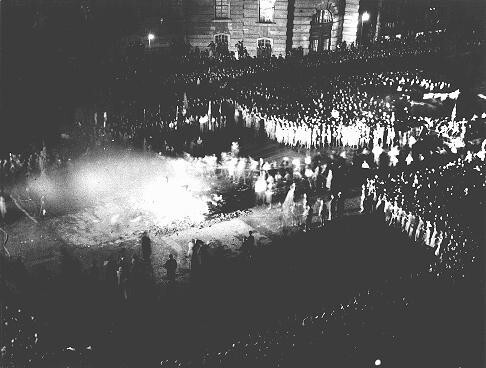
Book Burning May 10, 1933 Image courtesy US Holocaust Memorial Museum https://encyclopedia.ushmm.org/conten...
Can it happen here? It has.
Nearly a century before the Nazi book burnings, a concerted effort to flood the slaveholding states with abolitionist literature was met with fire. In the summer of 1835, an angry mob raided a Charleston, South Carolina post office and consigned thousands of abolitionist pamphlets to a bonfire. The book burning was topped off with an effigy of abolitionist William Lloyd Garrison being set ablaze. Garrison was lucky. Tragically, abolitionist publisher Elijah Lovejoy was not. Two years later, a mob intent on burning anti-slavery literature in Alton, Illinois murdered Lovejoy as he tried to defend his presses. A century later, in 1939, California growers burned Steinbeck’s Pulitzer Prize-winning The Grapes of Wrath.
Scrubbing the nation’s public square of “offensive” materials and torching books—despite the protections in the Bill of Rights—are as American as apple pie, lynch mobs, burning crosses, and now, tiki torches.
But there’s something new in the equation. The latest wave of book suppression is not simply about “subversion” or “dirty words.” Scratch the surface of recent book bans and it is clear that the assault on free expression cannot be separated from the larger Orwellian effort to sanitize American history, delegitimize literature by gay writers and people of color, and undermine democracy.
This revitalized onslaught carries the distinct whiff of white, Christian nationalism. This is the racial, cultural, and political ideology that once reared its head as nineteenth-century Nativism, the reinvigorated Ku Klux Klan of the 1920s, and the America Firsters of the 1930s.
Claiming that the United States is a “Christian nation,” this strand of anti-immigrant, anti-Catholic, and anti-Semitic American DNA is older than the nation itself. Time has not diminished its power. Now adding “globalists” to their enemies list, white Christian nationalism has been tied to the Charlottesville rioters who chanted “You will not replace us” and the January 6 insurrection by experts who study the movement.
America has no monopoly on this historically powerful faction. A form of white Christian nationalism, with its claims of racial superiority, certainly fed Hitler’s rise in Germany.
And that is why this revived wave of book suppression is a piece of a much larger development. The reason that Maus, a Pulitzer-Prize winning graphic novel-memoir about the Holocaust, was ostensibly pulled from schools in Tennessee was for some of its language and a discreet cartoon illustration of the author’s mother—an Auschwitz survivor—naked in the bathtub where she had committed suicide. But its critics apparently sought a kinder, gentler discussion of the Holocaust, although any attempts to soften that history tiptoe dangerously toward denialism. This is how history goes down 1984’s “Memory Hole.”
It is more than a little ironic that this onslaught of suppression comes as many on the Right decry the so-called “cancel culture” of the Left. Claiming their right to free speech is under attack, modern-day “book burners” crush that freedom under their boot heels as they attempt to distort or erase history and silence unwelcome voices. When such voices and ideas are deemed a threat and suppressed by the government, religious authorities, or a political party, we teeter on the thin ice of authoritarianism. The ice cracks when a fictional character is attacked—whether it is Homer Simpson, Huckleberry Finn, or Robin Hood. All three have come under fire over the years.
Banning books, legislating against “divisive concepts” in history class, and purging diversity all come straight from the playbook of the Strongman. He knows the power of the pen. Books make us think. Literature cultivates the free mind. Writers are truth-tellers. In 1917, Soviet leader Lenin ordered a “Decree on Press” threatening closure of publications critical of the Bolsheviks. Authoritarians know the danger posed by truth. And they are more than willing to use sword and flame to cut it down.
The question is what can we do about it?
“The antidote to authoritarianism is not some form of American authoritarianism,” Cooper Union librarian David K. Berninghausen told the Times in 1952. “The antidote is free inquiry.”
When Robin Hood was threatened by a textbook commissioner in 1953, some Indiana State University students fought back. Five of them gathered chicken feathers, dyed them green, and spread them across campus. Their protest caught on at other colleges, including UCLA, where two hundred students dressed up as Sherwood Forest’s Merry Men for a Green Feather drop. A clever, well-aimed protest, the Green Feather movement broke no windows or legs. Robin Hood was spared.
But those more innocent days are gone. In the internet age, the lines are more sharply drawn, sides set in stone, and the stakes much higher.
That is why dumping some green feathers or wearing an “I READ BANNED BOOKS” t-shirt will not be enough for this moment. If we care, we must take to heart Ike’s advice and “read every book.” We must firmly resolve to read. But buying and reading Maus or Toni Morrison’s Beloved are only the first steps.
We have to make sure that others can read these books. We must be audacious in support of free libraries and vigorously support all teachers who want to encourage students to read, debate, and think for themselves. And we must vigilantly push back on politicians and schoolboards purging libraries of uncomfortable truths. A few loud voices dominating a schoolboard or town hall meeting do not a majority make. To allow a noisy minority to dictate what we read and teach is skating on that thin ice of totalitarian loyalty oaths typical of a Mussolini or Stalin.
On this final note, history is clear. When you have succeeded in marking a writer as “degenerate” or “immoral”—as the Nazis did—you have moved towards dehumanizing them. It is a few short perilous steps from censorship to suppression to a conflagration far worse. In Berlin, on the spot where Nazis threw books into a bonfire, there is a plaque citing German playwright Heinrich Heine’s 1820 words, which read in part: “Where they burn books, they will ultimately burn people as well.”
The road to Hell is lit by burning books.
UPDATE: “A Fast-Growing Network of Conservative Groups Is Fueling a Surge in Book Bans” (New York Times, December 12, 2022)
UPDATE: “Virginia Legal Action Threatens the Freedom to Read” (National Coalition Against Censorship)
“This legal action could profoundly limit the availability of books in the Commonwealth of Virginia. No book has been banned for obscenity in the United States in more than 50 years. Prohibiting the sale of books is a form of censorship that cannot be tolerated under the First Amendment.”
I am also linking to this article from American Libraries, a publication of the American Library Association; “Same Fight, New Tactics,” which offers tips for meeting challenges to books in libraries.
Here are some key organizations leading the fight against book bans and other forms of censorship:
National Coalition Against Censorship
American Library Association (ALA) Office of Intellectual Freedom (OIF)
ACLU (American Civil Liberties Union) “What is Censorship?
© Copyright 2022, 2023 Kenneth C. Davis All rights reserved
The post When Robin Hood Was Blacklisted first appeared on Don't Know Much.
“Lives, Fortunes, Sacred Honor:” Whatever Became Of 56 Signers? (1st in a series)
(Post updated 6/20/2023)
Now that Juneteenth has become a national holiday observed as the other “Independence Day,” it is time to look back to the first Independence Day — July 4th, 1776.
As we approach Independence Day, we should rightly celebrate the ideas articulated in the nation’s founding document:
…that all men are created equal…
… they are endowed by their Creator with certain unalienable Rights, that among these are Life, Liberty and the pursuit of Happiness
… Governments are instituted among Men, deriving their just powers from the consent of the governed
Source: National Archives Declaration of Independence: A Transcription
These were radical ideas that changed the nation and the world. But as the nation is going through an examination of the role slavery played in American History, it is important to recognize its role to the Founders at Philadelphia.
You cannot teach American History without acknowledging the role slavery played. And talking about the men who signed the Declaration is one way to do that.
Read: “The American Contradiction: Conceived in Liberty, Born in Shackles” (Social Education, March/April 2020)
This is the first in a series of posts about the men who signed the Declaration of Independence and what became of them. Most of these men remain somewhat obscure. They have also been mythologized in some online forums. Many of them played a significant role in the early republic before, during, and after July 4, 1776. The entire series is posted in this site’s Blog category.
Slavery existed in all thirteen of the future states and at least 40 of the 56 signers enslaved people or were involved in the slave trade. One focus of the series is to show which of these men enslaved people or otherwise participated in the slave trade. A “YES” after their listing means they enslaved people; a “NO” means they did not.

Declaration of Independence (Source: National Archives https://www.archives.gov/founding-doc...
…We mutually pledge to each other our Lives, our Fortunes, and our Sacred Honor.
Those strong words concluded the Declaration of Independence when it was adopted by the Continental Congress on July 4, 1776. Then what happened?
There is little question that men who eventually signed that document were putting their lives at risk. The identity and fates of a handful of those Signers is well-known. Two future presidents — Adams and Jefferson— and America’s most famous man, Benjamin Franklin, were on the Committee that drafted the document.
But the names and fortunes of many of the other signers, including the most visible, John Hancock, are more obscure. In the days leading up to Independence Day, I will offer a thumbnail sketch of each of the Signers in alphabetical order. Some prospered and thrived; some did not: How many of those Signers actually paid with their Lives, Fortunes, and Sacred Honor?
–John Adams (Massachusetts) Aged 40 when he signed, he went on to become the first vice president and second president of the United States.
Adams was very smart. But he misjudged the nation’s birthday. After Congress voted on a resolution in favor independence on July 2, he was convinced that would be a day of celebration:
“The Second Day of July 1776 will be the most memorable Epocha, in the History of America. . . . It ought to be solemnized with Pomp and Parade, with Shews, Games, Sports, Guns, Bells, Bonfires, and Illuminations from one End of this Continent to the other from this Time forward forever more.”
–John Adams to Abigail Adams, July 3, 1776 ( National Archives)
By 1790, Adams was convinced that his place in the history to be written would be diminished.
“The history of our Revolution will be one continued lie from one end to the other,” he wrote fellow Founder Benjamin Rush in 1790.
“The essence of the whole will be that Dr. Franklin’s electrical rod smote the earth and out sprang General Washington. That Franklin electrified him with his rod –and thenceforward these two conducted all the policies,

Portrait of John Adams at age 88 by Jane Stuart, after Gilbert Stuart, 1824. (National Park Service)
negotiations, legislatures, and war.”
Adams died on the 50th anniversary of the Declaration in 1826 at age 90. (Jefferson died that same day) NO
The Adams house is a National Historical Park.
–Samuel Adams (Mass.) Older cousin to John, Samuel Adams was 53 at the signing. He went on to a career in state politics, initially refused to sign the Constitution because it lacked a Bill of Rights, and was governor of Massachusetts. He died in 1803 at 81. NO
–Josiah Bartlett (New Hampshire) Inspiring the name of the fictional president of West Wing fame on TV, Bartlett was a physician, aged 46 at the time of the signing. He helped ratify the Constitution in his home state, giving the document the necessary nine states to become the law of the land. Elected senator he chose to remain in New Hampshire as governor. Three of his sons and other descendants also became physicians. He died in 1795 at age 65. YES
–Carter Braxton (Virginia) A 39-year-old plantation owner, Braxton was looking to invest in the slave trade before the Revolution. Initially reluctant about independence, he helped fund the rebellion and lost a considerable fortune during the war — not because he was a signer, but because of shipping losses suffered during the war itself. He later served in the Virginia legislature and died in 1797 at age 61, far less wealthy than he had been, but also far from impoverished. YES
–Charles Carroll of Carrollton (Maryland) A plantation owner, 38 years old and one of America’s wealthiest men at the signing, Carroll was the only Roman Catholic signer and the last signer to die. With hundreds of enslaved people on his properties, Carroll considered freeing some of them before his death and later introduced a bill for gradual abolition in Maryland, which had no chance of passage. At age ninety-one, he laid the cornerstone of the Baltimore and Ohio Railroad as a member of its board of directors. He died in 1832 at age 95. YES
Update: Carroll’s cousin was John Carroll, a Jesuit priest, first Roman Catholic bishop in the United States, and a founder of Georgetown College. The New York Times has reported how, in 1838, Georgetown sold 272 enslaved people to keep the college financially afloat.

The post “Lives, Fortunes, Sacred Honor:” Whatever Became Of 56 Signers? (1st in a series) first appeared on Don't Know Much.
June 30, 2023
Whatever Became of 56 Signers? (11 of 11)
[Post revised 6/30/2023]
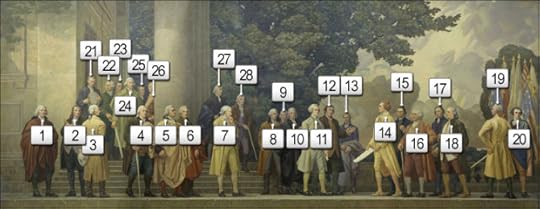
The Declaration Mural by Barry Faulkner (National Archives)
Key to Numbers in “The Declaration Mural” by Barry Faulkner
The final entry in a blog series profiling the 56 men who signed the Declaration of Independence. The series begins here. The previous posts can be found in this website’s Blog category.
AS THE NATION examines the role slavery played in its history, it is important to recognize that slavery was an issue in 1776. Among the men who eventually signed the Declaration, at least forty of them enslaved people or took part in the slave trade.
…We mutually pledge to each other our Lives, our Fortunes , and our Sacred Honor.
A New Hampshire slaver. A forgotten founder who died in debt and disgrace. A college president. A legendary bullet maker. Jefferson’s teacher –and a murder victim. Last but not least among the 56 signers. A “YES” following the entry means the Signer enslaved people; “NO” means he did not.
•William Whipple (New Hampshire) Often described as a 46-year-old “merchant,” he was more precisely a sea captain who made a fortune sailing between Africa and the West Indies — in other words, the merchandise was human cargo.
He also enslaved people and one of those men, known as Prince, accompanied Whipple throughout his illustrious career as an officer in the Revolution. It was thought that Prince was the Black man depicted in the famous “Washington Crossing the Delaware” painting. But that is not accurate because Prince and Whipple were far from the action that night. Whipple later served in a variety of state offices in New Hampshire and legally manumitted Prince –who also went by the name of Caleb Quotum — in 1784. Whipple died in Portsmouth in 1785. YES

Gravestone of Prince Whipple https://www.blackpast.org/african-ame...
•William Williams (Connecticut) A 45-year-old merchant, he was a veteran of the French and Indian War who was under command of his uncle Ephraim Williams, who was shot and killed in the war. (Ephraim Williams’s will provided funds for the founding of what became Williams College in Massachusetts.) Planning to follow his father as a minister, he attended Harvard but instead opened a store and became a successful merchant.
Williams married Mary Trumbull, the daughter of Connecticut’s Royal Governor. Governor Trumbull was a Royal Governor who supported the patriot cause and was a friend and adviser of George Washington. One of Mary Trumbull’s brothers, John Trumbull, became the most famous painter of the American Revolution, and another later became Connecticut’s Governor.
William Williams was not present for the July vote but signed the Declaration and was a tireless supporter of the war effort. After a long career in public service, he died in 1811, aged 81. NO
•James Wilson (Pennsylvania) Scottish-born, he was a 33-year-old lawyer at the time of the signing and one of the most important Founding Fathers you probably never heard of. A key supporter of the Declaration, Wilson was among the signers and Philadelphia elites who were attacked in his home during the war in a riot over food prices and scarcity.
Wilson was also a key member of the Constitutional Convention, credited with several significant compromises. Although hopeful to be made Chief Justice of the new Supreme Court, he was appointed an associate by Washington. But land speculation ruined him and he ended up in debtor’s prison, like his colleague Robert Morris (See series post #7) before his death in disgrace at age 55 in 1798, an embarrassment to his Federalist friends and colleagues. NO
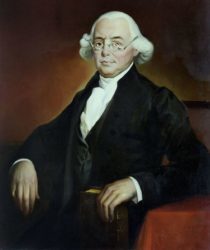
https://dontknowmuch.com/wp-admin/post.php?post=8045&action=edit The official portrait of Supreme Court Justice James Wilson.
•John Witherspoon (New Jersey) Another profoundly influential immigrant, the Scottish-born minister was the 53-year-old president of the College of New Jersey (later Princeton) where his hatred of the British influenced many students including notable schoolmates Aaron Burr and James Madison. He lost a son at the battle of Germantown in 1777, but continued his career in Congress. After the war, he attempted to rebuild the college and was a prime mover in the growth and organization of the Presbyterian Church. He died in 1794 in Princeton, where he is buried, at age 71. YES

A photograph of Maclean House, also called the President’s House, at Princeton University. Built 1756. https://commons.wikimedia.org/wiki/Fi...
•Oliver Wolcott (Connecticut) A 49-year-old lawyer, he was also a veteran of the French and Indian War who was not present for the vote and signed at a later date. Wolcott was in New York when Washington’s troops tore down a statue of King George III after hearing the Declaration of Independence read. He is credited with the plan to melt down the lead statue and turn it into bullets for the war effort. He served in the Connecticut militia during the Revolution and held a series of state posts after the war including as governor of Connecticut at his death in 1797, aged 71. YES
•George Wythe (Virginia) A 50-year-old lawyer at the signing, he may have made his greatest mark as a teacher of law to Thomas Jefferson who lived with Wythe while at the College of William and Mary –as well as later students including James Monroe, future Chief Justice John Marshall, and congressman Henry Clay, earning him the title “America’s first law professor.”
He died in 1806 , around 80, apparently murdered by a nephew by arsenic poisoning. The nephew was perturbed that Wythe had emancipated his enslaved people and planned to give half his estate to one of those emancipated people. The nephew was acquitted of murder after the testimony of a formerly enslaved woman was disallowed because she was black. The nephew was convicted of forging his uncle’s checks. YES

George Wythe, Signer of Declaration of Independence New York Public Library Digital Gallery (Digital Image ID: 484381)
Read the story of James Wilson and the Philadelphia Riot in America’s Hidden History.

Read more about slavery in the founding in my book IN THE SHADOW OF LIBERTY


Now In paperback THE HIDDEN HISTORY OF AMERICA AT WAR: Untold Tales from Yorktown to Fallujah
The post Whatever Became of 56 Signers? (11 of 11) first appeared on Don't Know Much.
June 29, 2023
Whatever Became of 56 Signers (Part 10 of 11)
[Post revised 6/29/2023]
This is Part 10 of a blog series profiling the 56 men who signed the Declaration of Independence. The series begins here. The previous posts can be found in the website Blog category.
As we approach Independence Day, we should rightly celebrate the ideas articulated in the nation’s founding document:
…that all men are created equal…
… they are endowed by their Creator with certain unalienable Rights, that among these are Life, Liberty and the pursuit of Happiness
… Governments are instituted among Men, deriving their just powers from the consent of the governed
Source: National Archives Declaration of Independence: A Transcription
The men who ultimately signed this document were taking an enormous risk:
…We mutually pledge to each other our Lives, our Fortunes , and our Sacred Honor.

Declaration of Independence (Source: National Archives https://www.archives.gov/founding-doc...
But we must also acknowledge another fact: You cannot teach American History without acknowledging the role slavery played. And talking about the men who signed the Declaration is one way to do that.
A victim of the British. Two Irish immigrants, one an indentured servant. A reluctant lawyer. An orphaned carpenter. (A Yes after their name means they enslaved people; a No means they did not.)
•Richard Stockton (New Jersey) Of the signers who paid for their actions, this successful and much-admired 45-year-old attorney at the signing, may have suffered most. Betrayed by Tory Loyalists in his home state, he was captured by the British in 1776, although later released in a prisoner exchange, not for having sworn allegiance to the King, as reported in a much-disputed rumor of the day. His New Jersey home was occupied and damaged by the British but later restored. Stockton was in poor health after the experience in captivity but lived until 1781, when he died of throat cancer.
Stockton is also credited with recruiting John Witherspoon, an influential Sottish minister, (See next installment in series) to become president of the College of New Jersey (later Princeton). His daughter, Julia, was married to Benjamin Rush, another signer.
“Stockton’s home ‘Morven’ had been occupied by British General Cornwallis. Dr. Benjamin Rush wrote: ‘The whole of Mr. Stockton’s furniture, apparel, and even valuable writings have been burnt. All his cattle, horses, hogs, sheep, grain and forage have been carried away by them. His losses cannot amount to less than five thousand pounds.’” (Source: The Society of the Descendants of the Signers.)
His home Morven, later served as the New Jersey Governor’s Mansion from 1954-1981. Today, his name is familiar to most people because there is rest stop on the New Jersey Turnpike named in his honor. YES
•Thomas Stone (Maryland) Among the conservatives in Congress, he was a 33-year-old attorney at the signing, reluctant about independence, but then joining in the favorable vote. He wrote:
“I wish to conduct affairs so that a just and honorable reconciliation should take place, or that we should be pretty unanimous in a resolution to fight it out for independence. The proper way to effect this is not to move too quick. But then we must take care to do everything which is necessary for our security and defense, not suffer ourselves to be lulled or wheedled by any deceptions, declarations or givings out. You know my heart wishes for peace upon terms of security and justice to America. But war, anything, is preferable to a surrender of our rights.” (Source: The Society of the Descendants of the Signers)

Thomas Stone’s home is a National Historic site. Habre de VentureFront View, September 2009 (Photo via wikimedia https://commons.wikimedia.org/wiki/Fi...
Another son of a wealthy planter, he had a low profile after the signing, helping write the Articles of Confederation but not signing them. He also declined to take part in the Constitutional Convention, when his wife, who fell ill following an earlier inoculation against smallpox, died in 1787. Apparently despondent, he died four months later in 1787 at age 44. YES
•George Taylor (Pennsylvania) Arriving in America as an indentured servant from Ireland, he was a 60-year-old merchant and iron maker at the signing. He had risen at the foundry where he worked to become bookkeeper, later purchased the business after his employer’s death, and then married the late owner’s widow.
Taylor was not in the influential Pennsylvania delegation for the July vote, but joined Congress when Loyalists in the Pennsylvania delegation were fored to resign. He signed the document in August. During the war, his foundry provided cannon and cannonballs for the war effort, but Congress was notoriously slow to pay its bills and his business suffered. He died in 1781 at age 65. YES
•Matthew Thornton (New Hampshire) An Irish-born physician, he was around 62 at the signing, a veteran surgeon who had served with the New Hampshire militia in the French and Indian War. A latecomer to Congress, he joined in November 1776 and was later permitted to add his name to the document. He later served as a state judge and then operated a farm and ferry before his death in 1803 at about age 89. NO
•George Walton (Georgia) Orphaned and apprenticed as a carpenter, he was a 35-year-old, self taught attorney at the signing. Although his exact birth date is unknown, some claim that he was the youngest Signer – a distinction usually given to Edward Rutledge (See previous entry).
Serving with the Georgia militia, he was shot and captured by the British in 1778. He was held for a year before being exchanged for a British officer –even though it was known he was a Signer. He later served in a variety of state offices, including governor and senator from Georgia, and built a home on lands confiscated after the war from a Tory, or Loyalist. He is implicated in the events that led to the duel that killed fellow signer and political rival Button Gwinnet (see Part 3 of series). He died in February 1804, presumably aged 63. NO
Update 6/29/2021:
“Unlike most men of property and influence in Georgia, Walton did not own slaves. There is little record of his public views on slavery, but it is known that shortly after leaving the governor’s mansion, Walton spoke out against what he called ‘barbarian’ treatment of members of an African-American Baptist congregation in Yamacraw, Georgia, in 1790.”
Read more about slavery in the founding in my book IN THE SHADOW OF LIBERTY

The post Whatever Became of 56 Signers (Part 10 of 11) first appeared on Don't Know Much.
June 28, 2023
Whatever Became of 56 Signers? (Part 9)
[Post updated 6/28/2023]
This is Part 9 of a blog series profiling the 56 men who signed the Declaration of Independence. The series begins here. The complete series can be found in the website Blog category.
As we approach Independence Day, we should rightly celebrate the ideas articulated in the nation’s founding document:
…that all men are created equal…
… they are endowed by their Creator with certain unalienable Rights, that among these are Life, Liberty and the pursuit of Happiness
… Governments are instituted among Men, deriving their just powers from the consent of the governed
Source: National Archives Declaration of Independence: A Transcription
The men who ultimately signed this document were taking an enormous risk:
…We mutually pledge to each other our Lives, our Fortunes , and our Sacred Honor.

Declaration of Independence (Source: National Archives https://www.archives.gov/founding-doc...
But we must also acknowledge another fact: You cannot teach American History without acknowledging the role slavery played. And talking about the men who signed the Declaration is one way to do that.
Betsy Ross’s uncle. The “first psychiatrist.” The youngest signer. The Great Compromiser. An Irishman named Smith. The next five signers. (A Yes after their name means they enslaved people; a No means they did not.)
•George Ross (Pennsylvania) The son of a Scottish-born minister, he was a 46-year-old attorney at the signing, a Loyalist or Tory, before turning to the Patriot cause in 1775. He served as a Colonel in the Pennsylvania militia. Yes, he was Betsy’s uncle by marriage, but the rest of the Ross flag story has been dismissed as family legend.
Ross left Congress in early 1777 due to illness — severe gout, a form of arthritis once described as the “rich man’s disease” that afflicted a number of other signers. He later served as a Pennsylvania judge before his death in 1779 at 49, following a severe attack of gout. NO

Dr Benjamin Rush by Charles Willson Peale c. 1783. Winterthur Museum
•Benjamin Rush (Pennsylvania) Raised by a widowed mother, he was a 30-year-old physician at the signing, youngest in the influential Pennsylvania delegation. He was elected after the July vote and his diaries, letters, and notes provided some of the best portraits of many of the signers and other founders.
He served as surgeon general of the armies during the war, and became an early abolitionist while still a slaveholder himself. Rush was also an early advocate of many modern medical practices, while at the same time practicing bloodletting. He established the first free medical clinic and remained in Philadelphia during a yellow fever epidemic in 1793 when the city was the nation’s capital, spoke against capital punishment, and in favor of the idea that there was mental illness which led to his being called “The Father of American Psychiatry.” He died of typhus in 1813 at age 67. YES
Rush is honored at Philadelphia’s Mütter Museum with a Medicinal Plant Garden bearing his name.
•Edward Rutledge (South Carolina) Son of an Irish immigrant physician, he was a 26-year-old attorney at the signing, the youngest of the signers. A wealthy planter as well as a much-admired attorney, Rutledge initially opposed the Declaration before changing his mind to support the favorable vote.
He later left Congress and was captured by the British while serving in the militia when Charleston fell in May 1780. He was held in St. Augustine for nearly a year. After the war, his finances and businesses flourished and he returned to state politics. Offered a Supreme Court seat by George Washington, he was instead elected governor of South Carolina in 1789, but died at age 50 in 1800, before his term ended. YES
•Roger Sherman (Connecticut) A self-educated son of a farmer, he was a prosperous merchant, attorney, and politician, aged 55 at the signing. He would sign four of the central documents in America’s foundation: the Continental Association, the Declaration (he was a member of the draft committee), the Articles of Confederation, and the U.S. Constitution
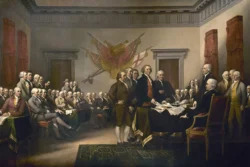
This painting by John Trumbull depicts the moment on June 28, 1776, when the first draft of the Declaration of Independence was presented to the Second Continental Congress. (Source: Architect of the Capitol) https://www.aoc.gov/explore-capitol-c...
It was at the 1787 Constitutional convention that Sherman proposed the “Great Compromise” that ended the deadlock between large and small states. He was also a true “Founding Father”– after Carroll (18 children) and Ellery (16 children), Sherman fathered the third most children among the signers -15. A leading Federalist, he served in the House and Senate, where he was serving at his death in 1793 at age 72. NO
•James Smith (Pennsylvania) Another immigrant signer, he was born in Northern Ireland and was around 57-years-old at the signing, another self-taught attorney. He had been an outspoken advocate of challenging oppressive British laws and called for the boycott of British goods that was later adopted by the First Continental Congress.
He also joined the Pennsylvania militia and was elected an officer. After the July vote, he signed the Declaration and then rode to York, Pennsylvania to have it read aloud on July 6. He served as Brigadier General of the Pennsylvania militia and later returned to law practice and state offices before his death in 1806 at about age 87. NO
Read: “The American Contradiction: Conceived in Liberty, Born in Shackles” (Social Education, March/April 2020)
And read about slavery in the founding in my book IN THE SHADOW OF LIBERTY

The post Whatever Became of 56 Signers? (Part 9) first appeared on Don't Know Much.
June 27, 2023
Whatever Became of 56 Signers? (Part 8)
[Updated 6/27/2023]
This is Part 8 of a blog series profiling the 56 men who signed the Declaration of Independence. The series begins here. The complete series can be found in this website’s Blog category.
In adopting and then signing the Declaration, these men were taking a significant risk. The closing words of the Declaration were not to be taken lightly.
…We mutually pledge to each other our Lives, our Fortunes , and our Sacred Honor.

Declaration of Independence (Source: National Archives https://www.archives.gov/founding-doc...
But it is also true that at least 40 of these 56 men who pledged themselves to the idea that “All Men are created” and are entitled to “life, liberty and the pursuit of happiness” enslaved people. A “YES” following an entry means the Signer enslaved people; “NO” means he did not.
Minister turned whaleboat captain and lawyer. Self-taught planters’ sons. A Nay vote. A rare bachelor. And a veiled man. The next six signers:
•Thomas Nelson, Jr. (Virginia) Another son of a wealthy planter, he was a 37-year-old merchant-planter at the signing who enslaved more than 400 people. He raised money to supply troops and even commanded militia. Legend has it that he fired a cannon at his own Yorktown mansion during the 1781 siege when told that it was British headquarters. The war cost him financially and he was in ill health, retiring as Virginia’s governor and living on his plantation until his death at 50 in 1789. YES
•William Paca (Maryland) An attorney and wealthy planter’s son, he was 35 at the signing. A patriot leader in somewhat conservative Maryland, Paca (pronounced Pay-cah) helped bring the state to favor independence at Philadelphia. He raised funds for the war effort and later, as Congressman, worked to support veterans.
During the Constitutional debate, Paca was a firm believer in states rights and individual rights, and led the Antifederalist movement in Maryland.
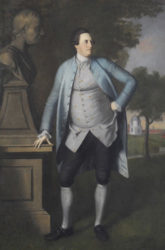
William Paca by Charles Willson Peale MSA SC 4680-10-0083 Source Maryland State House
“Even though he had many reservations, he voted in 1788 to approve the Constitution. He advocated 28 amendments to the Constitution, including those on freedom of religion, freedom of the press, and protection against judicial tyranny, and many of his proposed amendments became a part of the Bill of Rights.”
[Source: The Society of the Descendants of the Signers of the Declaration.]
He was twice married, but both wives died after childbirth, and Paca also fathered two children out of wedlock, one to a mixed race woman while serving in Philadelphia, according to the Society of the Descendants. He was later appointed a federal judge by President Washington, and was in that post at his death in 1799 at age 58. YES
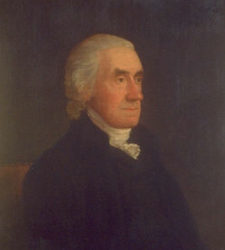
Robert Treat Paine (Courtesy: Massachusetts Historical Society, Boston, Massachusetts)
•Robert Treat Paine (Massachusetts) Overshadowed by two Adamses and Hancock, he was a minister turned attorney, 45-years-old at the signing, who had also been a sea captain on a whaler.
“In 1754, as Captain of the Seaflower, he led a whaling expedition from Cape Cod to Greenland and left behind what is believed to be the earliest illustrated log of a whaling venture kept by an American.” [Source: Society of the Descendants of the Signers]
He is perhaps best known as one of the prosecutors in the 1770 trial of the British soldiers charged in “Boston Massacre.” His friend and fellow delegate John Adams had served successfully as their defender. In 1780, he was among the founders of the American Academy of Arts and Sciences, one of the first American groups dedicated to expanding scientific knowledge and learning. After the war, he remained active in Massachusetts politics, becoming the state’s Attorney General, and was named a state judge by John Hancock until his retirement in 1804 due to deafness. He died in 1814 at age 83. NO
•John Penn (North Carolina) A wealthy planter’s son who taught himself to read and write, he was a 36-year-old attorney at the signing. He remained in Congress and was one of the signers who also signed the first American constitution, the Articles of Confederation. He retired to private law practice and died in 1788 at age 48. YES
•George Read ( Delaware) Among the conservative delegates, he was a 42-year-old lawyer at the time of the signing but had voted against independence on July 2. He served in state offices until ill health forced his resignation. But he returned to Philadelphia to take part in the Constitutional convention and was leading voice for small states’ rights and led the ratification forces in Delaware, the first state to ratify the Constitution. Elected to the Senate, he resigned to take a judgeship in Delaware before his death in 1798 at age 65. YES
•Caesar Rodney (Delaware) Another self educated attorney, son of a planter, he was 47 at the signing. He is perhaps best known for an 80-mile ride in a storm to break a deadlock that put Delaware in the Independence column –which cost him favor with conservatives in his home state. He later wrote in a letter:
“I arrived in Congress (tho detained by thunder and rain) time enough to give my voice in the matter of independence . . . We have now got through the whole of the declaration and ordered it to be printed so that you will soon have the pleasure of seeing it.” [Source: The Society of the Descendants]
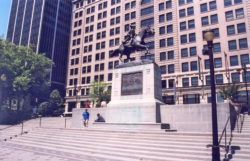
Statue of Caesar Rodney on his ride-Rodney Square Wilmington, DE (Public Domain)
Rodney also exemplifies the Great Contradiction of the Declaration, as he had earlier introduced legislation against the foreign slave trade:
“In 1766, as the Speaker of the [Delaware] Assembly, he introduced a bill to prohibit the importation of slaves into Delaware. At this time he was living in Byfield, a plantation of 1,000 acres, and owned 200 slaves. It is clear that he was pondering questions of the Colony’s and Mankind’s liberty and freedom. Indeed, at his death fourteen years later, he directed that all his slaves should be freed then, or shortly thereafter.” [Source: The Society of the Descendants]
One of the three bachelor signers (Francis Lee and Thomas Lynch were the others), Rodney remained in the Congress until he became Delaware’s state president. A cancerous growth on his face was untreated and he covered it with a silk veil, worn for a decade before his death in 1784 at age 55. YES
Read more about the place of slavery in the Founding of the United States in my book IN THE SHADOW OF LIBERTY.

The post Whatever Became of 56 Signers? (Part 8) first appeared on Don't Know Much.
June 26, 2023
Whatever Became of 56 Signers? (7th in series)
[Updated 6/26/2023]
As the role of slavery in the nation’s founding is debated and the teaching of a full and accurate American history is questioned, it must be made clear that slavery was central to the nation’s beginnings and institutions. One way to examine that is by looking at the men who signed the Declaration of Independence on July 4th, 1776.
Among the men who signed the Declaration, at least forty of them enslaved people or took part in the slave trade. This is Part 7 in a series that begins here. It tells the stories of what happened to the men who pledged “our Lives, our Fortunes, and our Sacred Honor.” Read the other entries here in my blog category.

Declaration of Independence (Source: National Archives https://www.archives.gov/founding-doc...
A tavern owner’s son. Two of America’s wealthiest men –both named Morris. And the first to die. The next five signers in this series. “YES” following the entry means the Signer enslaved people; “No” means he did not.
•Thomas McKean (Delaware) Son of a Pennsylvania farmer-tavern owner, McKean was a self educated, 42-year-old attorney turned politician at the time of the signing (although he did not sign in 1776).
in 1768 he was elected to the American Philosophical Society, a distinguished intellectual society founded by Benjamin Franklin. In 1769 McKean became a trustee of the Academy of Newark, the successor to Allison’s school at New London. He received honorary degrees from Princeton in 1781, Dartmouth in 1782 and Pennsylvania in 1785. Source: The Society of Descendants of the Signers of the Declaration.
A vigorous patriot, he held offices in both his native Pennsylvania and Delaware and was a key supporter of the Declaration. When another delegate from Delaware was absent and the state might vote against independence, McKean sent a horse and rider to collect fellow delegate Caesar Rodney and bring him back to vote — an 80-mile ride in a storm.
According to the National Constitution Center, as Pennsylvania judge:
McKean was a prominent early supporter of a strong judiciary, one strong enough to overturn a state law, if needed, as unconstitutional. He served for 22 years as Chief Justice for one of the most-influential state courts in the new republic.
He voted to approve the Declaration of Independence in July 1776, but he left Philadelphia before the document was signed, to rejoin the fight against the British.
Historians believe he was the last person to sign the document, either in early 1777 or as late as 1781.
McKean represented Delaware in the first two Continental Congresses, fought alongside George Washington and he briefly served as President of the Continental Congress in 1781, as British forces surrendered at Yorktown. McKean and his family were pursued by the British but never captured. A vocal advocate of the Constitution, he served in many state posts, including governor of Pennsylvania, and prospered after the war. He died in 1817 at age 83. YES
•Arthur Middleton (South Carolina) A 34-year-old plantation owner at the signing, he replaced his father –thought too conservative — in Congress. Educated in England, he became active in patriot politics. One of the few delegates to serve in the wartime militia, he was captured in Charleston in 1780, along with Thomas Heyward (Post #4) and Rutledge, two other South Carolina signers. Although his home had been destroyed he was released by the British and returned to Congress in 1781. After the war he returned to his plantation where he died at age 44 in 1787. YES
•Lewis Morris (New York) Another of the wealthy members of prominent New York families in the state’s delegation, Morris was a 50-year-old land owner with large holdings in what is now the Bronx in New York City. Although his home was assaulted by British troops during the war, it was attacked and severely damaged because of its value, not because he was a signer. Morris led troops of the militia during the vote in July, but then led the New York delegation in later signing the Declaration, making it unanimous. Morris rebuilt the family home and land holdings after the war and was a leader with Alexander Hamilton in ratification of the Constitution. He died in 1798, aged 71 and his former plantation is known today as the Morrisania section of the Bronx. YES
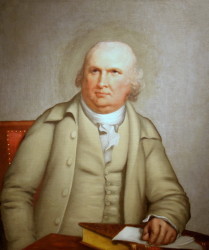
Oil painting of Robert Morris by Robert Pine (c. 1785)
•Robert Morris (Pennsylvania) (No relation to Lewis Morris above.) One of the wealthiest individuals in America, he was a 42-year-old Philadelphia merchant and speculator when he signed. Born in Liverpool, he had come to America and made a fortune as a merchant, becoming the “Financier of the Revolution.” Accused of profiteering during the war, he was attacked in the Philadelphia home of fellow signer James Wilson. A delegate to the Constitutional Convention in 1787, he declined to serve as Washington’s secretary of Treasury, recommending Alexander Hamilton instead. He later became a Senator. But he lost his fortune through land speculation and was bankrupted and put in debtor’s prison. He died in poverty and relative obscurity in 1806, aged 72. YES
•John Morton (Pennsylvania) A farm boy turned surveyor, he was 52-years-old at the time of the signing. He has two key distinctions: his vote pushed Pennsylvania into the pro-independence camp and he was first signer to die.A member of the committee writing the Articles of Confederation, he fell ill with tuberculosis in 1777 and died before they were ratified, at about age 52. He left his farm and enslaved people to his wife and children who had to flee from a British attack. YES
Read more about the place of slavery in the Founding of the United States in my book IN THE SHADOW OF LIBERTY.

The post Whatever Became of 56 Signers? (7th in series) first appeared on Don't Know Much.
June 25, 2023
Whatever Became of 56 Signers? (6th in a series)
[Post updated 6/25/2023]
This is the sixth in a series of posts about the men who signed the Declaration of Independence and what became of them. The series begins here. Or follow the series here.
…We mutually pledge to each other our Lives, our Fortunes , and our Sacred Honor.
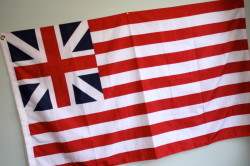
The Grand Flag of the Union, first raised in 1775 and by George Washington in early 1776 in Boston. The Stars and Stripes did not become the “American flag” until June 14, 1777. (Author photo © Kenneth C. Davis)
As the nation goes through an examination of the role slavery played in American History, it is important to recognize its place in Philadelphia in 1776. You cannot teach American History without acknowledging that slavery was central to the founding of the country. And talking about the men who signed the Declaration is one way to do that. The Yes after a name means the Signer enslaved people; No means he did not.
In this group: More wealthy planters and a couple of very wealthy New York merchants.
•Richard Henry Lee (Virginia) A 41-year-old planter from a prominent Virginia family –his younger brother Francis Lightfoot (See previous post) was also there– Lee deserves more acclaim than he usually gets. A “great orator,” said John Adams, Lee introduced the resolution for independence. He left Congress to attend to state business in Virginia and didn’t vote for the resolution or the Declaration, which he signed later in the summer of 1776.
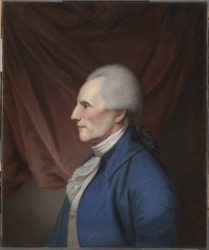
Richard Henry Lee National Portrait Gallery, Smithsonian Institution; gift of Duncan Lee and his son, Gavin Dunbar Lee
He was one of the few signers to actually serve with a Virginia militia unit. He remained in politics after the war, becoming a vocal opponent of the Constitution but an advocate for the Bill of Rights. He was elected to the U.S. Senate but resigned in ill health and died at age 62 in 1794. YES
•Francis Lewis (New York) A native of Wales, he was a 63-year-old merchant at the time of the signing, a key supporter of George Washington, but was instructed not to vote for the Declaration by New York. He then signed in August. During the war, his wife was imprisoned by the British and died shortly after her release, leaving Lewis grief-stricken. He died in 1802 at age 89, was buried in an unmarked grave at Manhattan’s Trinity Church, and now, curious New Yorkers will know why there is a Francis Lewis Boulevard in Queens. YES
•Philip Livingston (New York) The 60-year-old member of one of New York’s wealthiest families, with an estate of 160,000 acres on the Hudson River, he was a merchant who favored the patriot cause. But like many New Yorkers, he was more moderate and cautious about declaring independence and was absent when the entire New York delegation abstained from the vote. He signed in August. (Robert Livingston, a cousin and member of the Declaration draft committee, was also absent from the vote and never signed the Declaration).
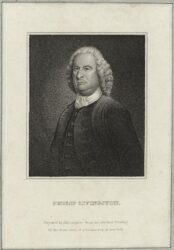
Philip Livingston (New York Public Library) https://digitalcollections.nypl.org/i...
“General Washington and his officers met at Philip’s residence in Brooklyn Heights after their defeat in the battle of Long Island, and decided to evacuate the island. The British subsequently used Philip’s Duke Street home as a barracks, and his Brooklyn Heights residence as a Royal Navy hospital. As the British occupied New York City, Philip and his family fled to Kingston, NY where he maintained another residence. Later, the British burned the city of Kingston to the ground as they did Robert R. Livingston’s mansion, Clermont, across the Hudson River.” (Source: Society of the Descendants of the Signers of the Declaration of Independence
Although he sold some of his property to support the war effort, his family continued to amass large land holdings in upstate New York. In poor health, he died at age 62 in 1778, when Congress was forced to evacuate Philadelphia and move to York, Pa. YES
•Thomas Lynch, Jr. (South Carolina) At 27, the second youngest signer (after Edward Rutledge also of South Carolina), he was born on one of the South’s major rice plantations. A lawyer, he was the son of a a wealthy rice planter, who suffered a stroke while a delegate in Philadephia. The younger Lynch was sent to Congress. (His father was unable to vote or sign.) Both left for home in poor health and the elder Lynch died en route.
During the debates after the adoption, Lynch was reported by John Adams to threaten secession:
If it is debated, whether their Slaves are their Property, there is an End of the Confederation. Our Slaves being our Property, why should they be taxed more than the Land, Sheep, Cattle, Horses, &c.
Source: John Adams diary 27, May – 10 September 1776 [electronic edition]. Adams Family Papers: An Electronic Archive. Massachusetts Historical Society.

Hopsewee Plantation (Photo credit Alan Sherlock via Historic Hopsewee)
Lynch Jr. and his wife later sailed for the West Indies in the hope of regaining his health but both died at sea in 1779 when their ship was lost in a storm. Among the youngest signers, he was the youngest signer to die at age 30. YES
Read more about slavery and the Founders in my book IN THE SHADOW OF LIBERTY.

The post Whatever Became of 56 Signers? (6th in a series) first appeared on Don't Know Much.
June 24, 2023
Whatever Became of 56 Signers? (5th in a series)
[Post updated 6/24/2023]
Slave trader turned abolitionist. Flag designer. “First President.” Member of a Virginia dynasty. And the Author.

Jefferson’s Desk on which he drafted the Declaration (Image: National Museum of American History/Smithsonian)
This is the fifth in a series of posts about the men who signed the Declaration of Independence and what became of them. The series begins here. Or follow the series here.
As the nation debates the role slavery played in American History and some seek to minimize its significance, it is important to recognize its place in Philadelphia as the Declaration was debated.
You cannot teach American History without acknowledging the role slavery played. And talking about the men who signed the Declaration is one way to do that. Slavery existed in all thirteen of the future states and at least 40 of the 56 signers enslaved people or were involved in the slave trade. One focus of the series is to show which of these men enslaved people or otherwise participated in the slave trade. (A Yes means the Signer enslaved people; No means he did not.)
•Stephen Hopkins (Rhode Island) Second oldest delegate after Franklin, Hopkins was 69-years-old at the signing. A merchant, he had been Rhode Island’s colonial governor but was an outspoken advocate of independence having written a document entitled, The Rights of the Colonies Examined in 1764.
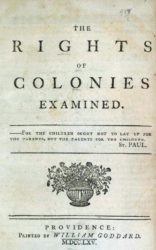
“Rights of the Colonies Examined” (1765 :Source Wikimedia Commons
A partner of the wealthy Brown brothers who were involved in the slave trade –Newport was a key northern slavery port– he enslaved several people. The role of Stephen Hopkins, his brother Esek -captain of a slave ship- and the Brown brothers as enslavers and the founding of what became Brown University is detailed in a report commissioned by Brown called Slavery and Justice.
But in 1774, he secured passage of law prohibiting the slave trade in Rhode Island, one of the first anti-slavery laws in the colonies and he began freeing some but not all of the people he enslaved. In ill health, he retired from politics and public life and died in 1785 at age 78. YES
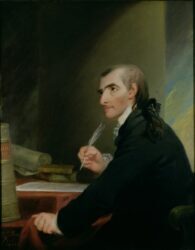
Francis Hopkinson by Robert Edge Pine (1785) Source: Historical Society of Pennsylvania Collection, Philadelphia History Museum at the Atwater Kent, Philadelphia, PA.
•Francis Hopkinson (New Jersey) Like Franklin and Jefferson, Hopkinson was a man of many talents, a 38-year-old attorney and musician at the time of the signing. He was the son of the founder –with Franklin– of the University of Pennsylvania and was among the school’s first graduates. Though long overlooked, he has more recently gotten his due as the designer of the “Stars and Stripes.” The claim is based on Hopkinson submitting a bill for his work on the flag and requesting “a quarter cask of the public wine” in payment. He was already on the Congressional payroll so the request was refused. While his home was ransacked during the war, he emerged relatively unscathed and later became a Federal judge before his death in 1791 at 53. YES
•Samuel Huntington (Connecticut) An apprenticed barrel-maker who became a successful attorney, he was a 45-year-old politician at the time of the signing, having resigned his post as “King’s Attorney.” His true distinction is serving as “President of the United States in Congress Assembled” when the Articles of Confederation were adopted –making him the “First President,” sort of. Others have staked that claim as well. He served in a variety of national and state posts, including being the sitting governor of Connecticut at his death in 1796 at age 64. NO
•Thomas Jefferson (Virginia) 33-year-old planter, scientist, writer, and lawyer. You know most of the rest. But Jefferson’s wartime service as Virginia’s governor is sometimes overlooked. In 1781, he was Virginia’s governor when the British attacked the state, including forces led by Benedict Arnold. Jefferson fled and was later investigated by the state legislature but no charges were filed. People enslaved by Jefferson were captured by the British and were being held in Yorktown during the siege in September-October 1781 and were later returned to Jefferson by George Washington.

Thomas Jefferson’s Grave Marker at Monticello (Author photo)
He died, like John Adams, on the 50th anniversary of the adoption –July 4, 1826. See the Monticello site for more information. YES
–Francis Lightfoot Lee (Virginia) A member of the state’s prominent planter family, he was 41 years old at the signing, the quiet brother of Richard Henry Lee, who offered the first resolution calling for independence in June 1776. After the war, he was a prominent advocate of the new Constitution, unlike his more visible older brother. He left the national scene and died at age 62 in 1797. YES
Read more about the Founders and Slavery in my book IN THE SHADOW OF LIBERTY

The post Whatever Became of 56 Signers? (5th in a series) first appeared on Don't Know Much.




